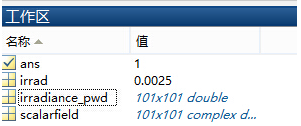-
UID:317649
-
- 注册时间2020-06-19
- 最后登录2025-12-22
- 在线时间1894小时
-
-
访问TA的空间加好友用道具

|
简介:FRED作为COM组件可以实现与Excel、VB、Matlab等调用来完成庞大的计算任务或画图,本文的目的是通过运行一个案例来实现与Matlab的相互调用,在此我们需要借助脚本来完成,此脚本为视为通用型脚本。 EBiLe;�=�X �l�CBH3-0^ 配置:在执行调用之前,我们需要在Matlab命令行窗口输入如下命令: �e/#6qCE� enableservice('AutomationServer', true) J^S!�GG'gb enableservice('AutomationServer') kD7'�BP/�#  TjI&8#AWBA 结果输出为1,这种操作方式保证了当前的Matlab实体可以用于通信。 Dt�J�3`J�d ?%�#no{��9 在winwrp界面,为增加和使用Matlab类型的目录库,我们需要如下步骤: K\��z�b��+ 1. 在FRED脚本编辑界面找到参考. ~*]�7f%�L- 2. 找到Matlab Automation Server Type Library [:q�J1^U�U 3. 将名字改为MLAPP L�C$�M_Cpw �0)7v��_|z }RKsS3} �� 在Matlab里面有两种常用的数据发送选项PutWorkspaceData 及PutFullMatrix,PutWorkspaceData适用于存储一般的数据在工作区,并赋予其为变量,PutFullMatrix试用于复数数据。 g3^�:�)$m� uH,/S��4?X TjI&8#AWBA 结果输出为1,这种操作方式保证了当前的Matlab实体可以用于通信。 Dt�J�3`J�d ?%�#no{��9 在winwrp界面,为增加和使用Matlab类型的目录库,我们需要如下步骤: K\��z�b��+ 1. 在FRED脚本编辑界面找到参考. ~*]�7f%�L- 2. 找到Matlab Automation Server Type Library [:q�J1^U�U 3. 将名字改为MLAPP L�C$�M_Cpw �0)7v��_|z }RKsS3} �� 在Matlab里面有两种常用的数据发送选项PutWorkspaceData 及PutFullMatrix,PutWorkspaceData适用于存储一般的数据在工作区,并赋予其为变量,PutFullMatrix试用于复数数据。 g3^�:�)$m� uH,/S��4?X 图 编辑/参考 :$gs7<z{rm q�g|ark*1u 现在将脚本代码公布如下,此脚本执行如下几个步骤: �L3'isaz&^ 1. 创建Matlab服务器。 h9!4\�{V;h 2. 移动探测面对于前一聚焦面的位置。
+U%ep��q� 3. 在探测面追迹光线 94|ZY�}8|f 4. 在探测面计算照度 ��,4� q�^( 5. 使用PutWorkspaceData发送照度数据到Matlab hJ8%�r_��� 6. 使用PutFullMatrix发送标量场数据到Matlab中 N�U+�PG`Vb 7. 用Matlab画出照度数据 )��X:Sf��k 8. 在Matlab计算照度平均值 T 1_B0H�2 9. 返回数据到FRED中 h�l]� y�): o���iC@ �/ 代码分享: /�m,i,NX07 G�N�=8;Kq% Option Explicit t0k��ZFU�� �cLvn�LaA} Sub Main g0��;��;+z �{P\Ob0�)q Dim ana As T_ANALYSIS m�AY/��J0_ Dim move As T_OPERATION Gp�cor�dt/ Dim Matlab As MLApp.MLApp %s�9�*?6� Dim detNode As Long, detSurfNode As Long, anaSurfNode As Long �o|c��&$)m Dim raysUsed As Long, nXpx As Long, nYpx As Long a�Y;34�SF Dim irrad() As Double, imagData() As Double, reals() As Double, imags() As Double g&�� f)WQ( Dim z As Double, xMin As Double, xMax As Double, yMin As Double, yMax As Double }NRt�:J�C� Dim meanVal As Variant ;l<He�n��* 0pl�'�*r*9 Set Matlab = CreateObject("Matlab.Application") �\2�#K� { ;]=@;? �9� ClearOutputWindow [eB�t Dc*w W(���?J,8> 'Find the node numbers for the entities being used. u,}>��I%21 detNode = FindFullName("Geometry.Screen") 2PUB@B�'
+ detSurfNode = FindFullName("Geometry.Screen.Surf 1") vpOGyv��I� anaSurfNode = FindFullName("Analysis Surface(s).Analysis 1") Pth�4_]U�S ��+Z�G���H 'Load the properties of the analysis surface being used. mA_Evz�Xk\ LoadAnalysis anaSurfNode, ana <�<Y]P�+uU ;=E}Pb�Zt2 'Move the detector custom element to the desired z position. RBg2iG$�8| z = 50 *�C�Az�_s< GetOperation detNode,1,move C8�Y��StT� move.Type = "Shift" &�gJ�@"`r4 move.val3 = z :_2:Fh.}3~ SetOperation detNode,1,move Z�y{hY��HQ Print "New screen position, z = " &z SB5qm?pT8< odJE~\\hw� 'Update the model and trace rays. =knLkbiq7, EnableTextPrinting (False) �DT6�BFx�� Update ~k?��t���� DeleteRays 2`ERrh^i�" TraceCreateDraw !=yO72dgLY EnableTextPrinting (True) 2�chT�^3�e NwQ$gDgu t 'Calculate the irradiance for rays on the detector surface. 7lJ8<EP9
u raysUsed = Irradiance( detSurfNode, -1, ana, irrad ) q$�I�U�!I4 Print raysUsed & " rays were included in the irradiance calculation. NNTrH\SU�# Sr�Ov*
D�3 'When using real number data to send to MATLAB, it is simplest to use PutWorkspaceData. ��^�h#A7 g Matlab.PutWorkspaceData("irradiance_pwd","base",irrad) cI�k�A ~�F (Ia�:>ocE0 'PutFullMatrix is more useful when actually having complex data such as with pCa~:q�*85 'scalar wavefield, for example. Note that the scalarfield array in MATLAB �N"Y%*�BkH 'is a complex valued array. ~x_(v��,NW raysUsed = ScalarField ( detSurfNode, -1, ana, reals, imags ) E��5c)\
D� Matlab.PutFullMatrix("scalarfield","base", reals, imags ) �}g%&}`�%' Print raysUsed & " rays were included in the scalar field calculation." 9o6�qN1A0g Q&%gpa�).W 'Calculate plot characteristics from the T_ANALYSIS structure. This information is used RC8-6s& ln 'to customize the plot figure. %��?qzP��' xMin = ana.posX+ana.AcellX*(ana.Amin-0.5)
2)n�%rvCQ xMax = ana.posX+ana.AcellX*(ana.Amax+0.5) %$Q�!'+Y�W yMin = ana.posY+ana.BcellY*(ana.Bmin-0.5) Y2�N$&]O{� yMax = ana.posY+ana.BcellY*(ana.Bmax+0.5) �L;b-=m�F� nXpx = ana.Amax-ana.Amin+1 98_os��2`� nYpx = ana.Bmax-ana.Bmin+1 YY'[PX�P$Y W&Xi�&[Ux 'Plot the data in Matlab with some parameters calculated from the T_ANALYSIS rEU�1
V�vE 'structure. Set the axes labels, title, colorbar and plot view. ^<v.=7cL0 Matlab.Execute( "figure; surf(linspace("&xMin &","&xMax &","&nXpx &"),linspace("& yMin &"," & yMax & "," & nYpx & "),irradiance_pwd, 'EdgeColor', 'None');" ) "/U�Pq6�� Matlab.Execute( "xlabel('X Position (" & GetUnits() & ")')" ) : Matlab.Execute( "ylabel('Y Position (" & GetUnits() & ")')" ) : Matlab.Execute( "zLabel( 'Irradiance' )" ) �|L�-- ��j Matlab.Execute( "title('Detector Irradiance')" ) |BGzdBm^x: Matlab.Execute( "colorbar" ) �`�$3P@SO" Matlab.Execute( "view(2)" ) t�Eib�x�E� Print "" fg1uqS1rg� Print "Matlab figure plotted..." ]Rp<�64I o [�r'��hX# 'Have Matlab calculate and return the mean value. SxC(:k2b; Matlab.Execute( "irrad = mean(mean(irradiance_pwd));" ) m^)�\P?M5| Matlab.GetWorkspaceData( "irrad", "base", meanVal ) �Th�~�pj�u Print "The mean irradiance value calculated by Matlab is: " & meanVal [!ZYtp?H�f �t�d#m>S� 'Release resources *1>T�c�,mb Set Matlab = Nothing �Ys��O`1�D W^��3'9nYU End Sub jd�
8g0��^ 'XSHl?��+q 最后在Matlab画图如下: 7��FP"]\x ~H]��d9�C� 并在工作区保存了数据: y>R�qA��*J kQ)2DCb�dn  3�|A��r~_] 3�|A��r~_]
Ac��[;S!R� 与FRED中计算的照度图对比: T(�~^X�-�k P|aSbsk:I< 例: G0ENk|wbbj HI)��U�6.' 此例系统数据,可按照此数据建立模型 ]��;0:aSi#
Uf$IH�!5;Z 系统数据 wo^1%:@/�2
��W*4!A�\K (Pt*|@i2�c 光源数据: zH��@�+\#M Type: Laser Beam(Gaussian 00 mode) {Z[kvXf"mZ Beam size: 5; A�CgW���T� Grid size: 12; ZPY84)�A_} Sample pts: 100; ayA_[{j%X� 相干光; d��BW#P�Rg 波长0.5876微米, bH��H�R^*B 距离原点沿着Z轴负方向25mm。 -%��t8a42� uYc�&Q�$�U 对于执行代码,如果想保存图片,请在开始之前一定要执行如下代码: \<y#$:4r<8 enableservice('AutomationServer', true) ;[Hr��pl
S enableservice('AutomationServer') �8ZO~�=e�� �8ZO~�=e��
|